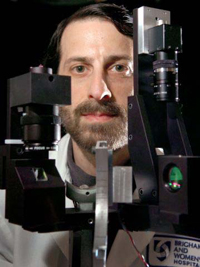New BU Prof Offers Hope for Alzheimer’s
Early detection technology could slow disease's progress

Lee E. Goldstein is on a quest to eradicate Alzheimer’s disease, andhe’s racing the clock. “The disease will bankrupt the U.S. health-caresystem if we don’t intervene soon,” he says. “We simply won’t have theresources to handle the number of people who develop the disease.”
Thekey, says Goldstein — who is joining the faculty at BU’s School ofMedicine in the departments of psychiatry, ophthalmology, neurology,pathology, and laboratory medicine and the College of Engineering inthe department of biomedical engineering — is early detection. Andbased on a chance discovery, Goldstein and his colleagues aredeveloping a laser-based diagnostic technology that will detect thedisease years — and possibly decades — before the first symptoms emerge.
Goldstein,formerly an assistant professor of psychiatry at Harvard Medical Schooland the director of the Molecular Aging and Development Laboratory andthe Center for Biomedical Metallomics at Brigham and Women’s Hospital,has brought his research team to BU to continue their work at two newstate-of-the-art research facilities, one located at the BioSquareResearch Park on the Medical Campus and the other at the BU Photonics Center on the Charles River Campus. Goldstein is also joining the research faculty at the Photonics Center.
“Myteam and I are honored to join the Boston University community,”Goldstein says. “The research dynamism at BU affords very powerful,complementary support for our interdisciplinary translationalneuroscience research.” Members of Goldstein’s research team includeMark Burton, Noel Casey, Joy Ghosh, Anca Mocofanescu, Juliet Moncaster,and Weilan Xu.
Alzheimer’s disease, the leading cause ofdementia and the seventh-leading cause of death in the United States in2004, according to the Alzheimer’s Association,occurs when sticky, tangled plaques containing deposits of the proteinfragment beta-amyloid build up between nerve cells in the brain. Fouryears ago, Goldstein and his research team determined that this amyloidprotein also collects in the lens of eyes in people afflicted withAlzheimer’s disease and causes an unusual cataract that is completelydifferent from common age-related cataracts. The findings werepublished in the British medical journal The Lancet.
“Iwas working with Alzheimer’s mice,” he says, “and I noticed they weredeveloping dense bilateral cataracts in their eyes.” Healthy controlmice, on the other hand, showed no signs of cataracts. Goldstein thenlooked at the eyes of people with Alzheimer’s disease and found thesame cataracts. The discovery established the first evidence ofAlzheimer’s-linked pathology outside the brain, and led Goldstein andhis colleagues to develop a laser-based diagnostic technology thatsearches for amyloid protein buildup in the eyes and could aid in earlydetection of the disease.
“Alzheimer’s is an exceedingly slowdisease that starts many years to a decade or more before the beginningof cognitive decline,” Goldstein says. “With the emerging treatmentscoming on line, we can beat back this disease, but only if we begintreatment early, long before the onset of clinical symptoms. If we cancombine emerging new treatments with early detection, we can beat thisdisease and do so soon."
Goldstein hopes that in another threeyears or so, adults will be able to ask their physician for alaser-based molecular diagnostic screening test for Alzheimer’sdisease. Six years ago, he cofounded Neuroptix Corporation,an Acton-based biotech company that is spearheading lead-edge lasertechnology for detection of abnormal accumulation of the beta-amyloidproteins in the lens of the eye — the same proteins that causebrain-cell death in Alzheimer’s patients — using a laser eye-scanningdevice and eye drops.
“Our most recent work suggests thatwe may be able to detect the disease at the molecular level from theearliest stages of the disease, hopefully well before the firstclinical symptoms," Goldstein says. "Once you show the classic signs ofAlzheimer’s — forgetfulness or disorientation — it’s the beginning ofthe end. That’s why early detection is so crucial. We want to stop itbefore it starts.”
Goldstein is also driven by personalexperience with the disease and its effects: around the time hediscovered the connection between Alzheimer’s and cataracts,Goldstein’s father-in-law was diagnosed with frontotemporal dementia(FTD), a rare and particularly brutal neurodegenerative disease thataffects the frontal and temporal lobes of the brain — the areasgenerally associated with personality and behavior.
“I’m ageriatric psychiatrist and a neuroscientist by training,” he says,“and my research is driven by a passionate desire to help myfather-in-law, my patients, and my patients’ families.”
Vicky Waltz can be reached at vwaltz@bu.edu.
Comments & Discussion
Boston University moderates comments to facilitate an informed, substantive, civil conversation. Abusive, profane, self-promotional, misleading, incoherent or off-topic comments will be rejected. Moderators are staffed during regular business hours (EST) and can only accept comments written in English. Statistics or facts must include a citation or a link to the citation.